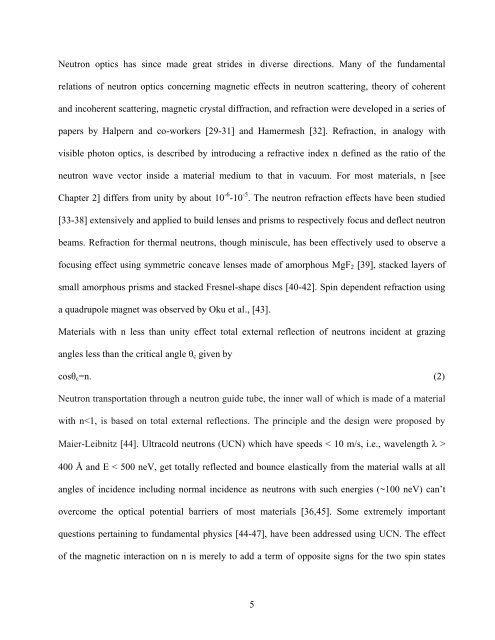PHYS01200804001 Sohrab Abbas - Homi Bhabha National Institute
PHYS01200804001 Sohrab Abbas - Homi Bhabha National Institute
PHYS01200804001 Sohrab Abbas - Homi Bhabha National Institute
Create successful ePaper yourself
Turn your PDF publications into a flip-book with our unique Google optimized e-Paper software.
Neutron optics has since made great strides in diverse directions. Many of the fundamental<br />
relations of neutron optics concerning magnetic effects in neutron scattering, theory of coherent<br />
and incoherent scattering, magnetic crystal diffraction, and refraction were developed in a series of<br />
papers by Halpern and co-workers [29-31] and Hamermesh [32]. Refraction, in analogy with<br />
visible photon optics, is described by introducing a refractive index n defined as the ratio of the<br />
neutron wave vector inside a material medium to that in vacuum. For most materials, n [see<br />
Chapter 2] differs from unity by about 10 -6 -10 -5 . The neutron refraction effects have been studied<br />
[33-38] extensively and applied to build lenses and prisms to respectively focus and deflect neutron<br />
beams. Refraction for thermal neutrons, though miniscule, has been effectively used to observe a<br />
focusing effect using symmetric concave lenses made of amorphous MgF 2 [39], stacked layers of<br />
small amorphous prisms and stacked Fresnel-shape discs [40-42]. Spin dependent refraction using<br />
a quadrupole magnet was observed by Oku et al., [43].<br />
Materials with n less than unity effect total external reflection of neutrons incident at grazing<br />
angles less than the critical angle θ c given by<br />
cosθ c =n. (2)<br />
Neutron transportation through a neutron guide tube, the inner wall of which is made of a material<br />
with n<br />
400 Å and E < 500 neV, get totally reflected and bounce elastically from the material walls at all<br />
angles of incidence including normal incidence as neutrons with such energies (~100 neV) can’t<br />
overcome the optical potential barriers of most materials [36,45]. Some extremely important<br />
questions pertaining to fundamental physics [44-47], have been addressed using UCN. The effect<br />
of the magnetic interaction on n is merely to add a term of opposite signs for the two spin states<br />
5
















